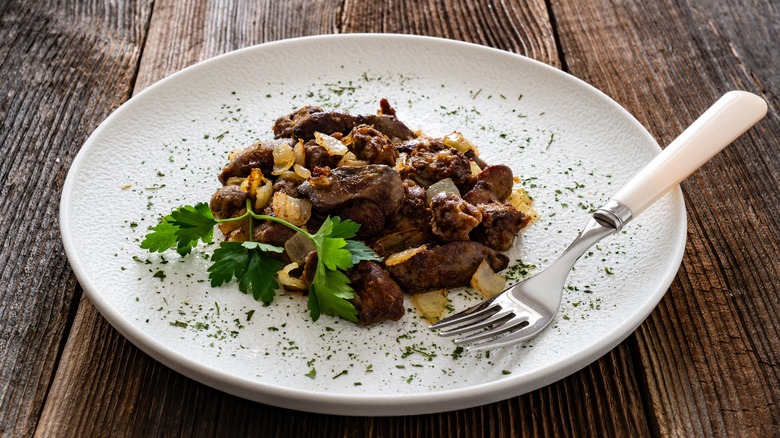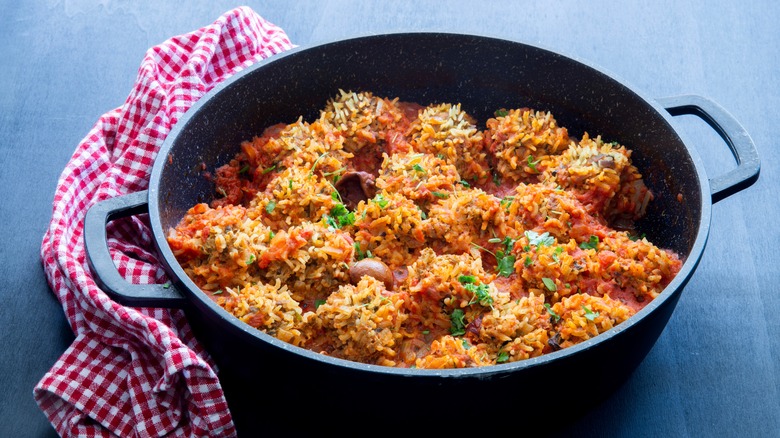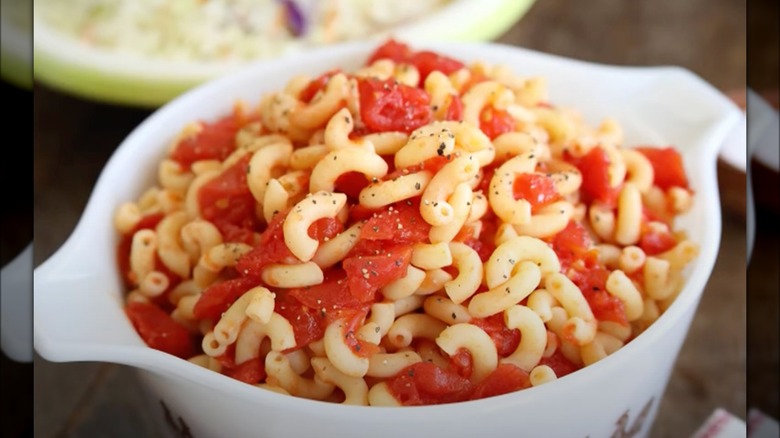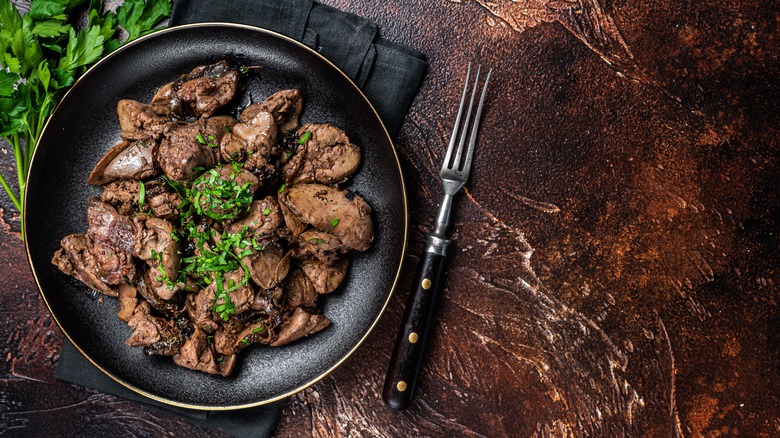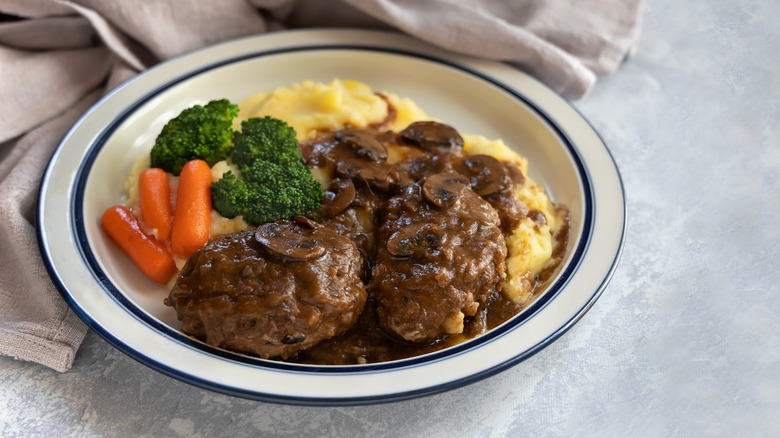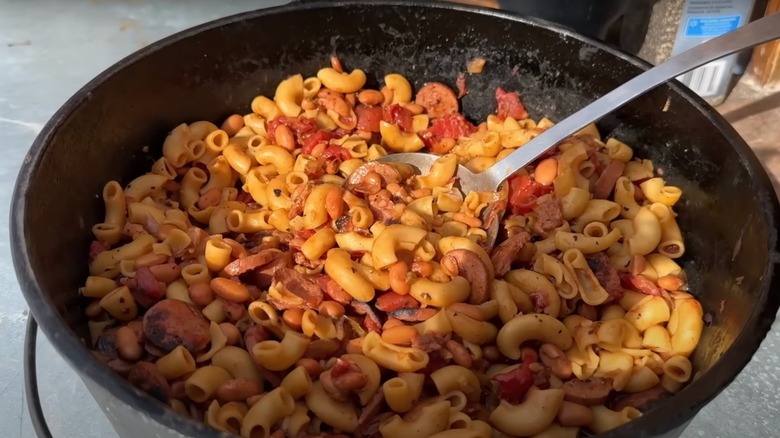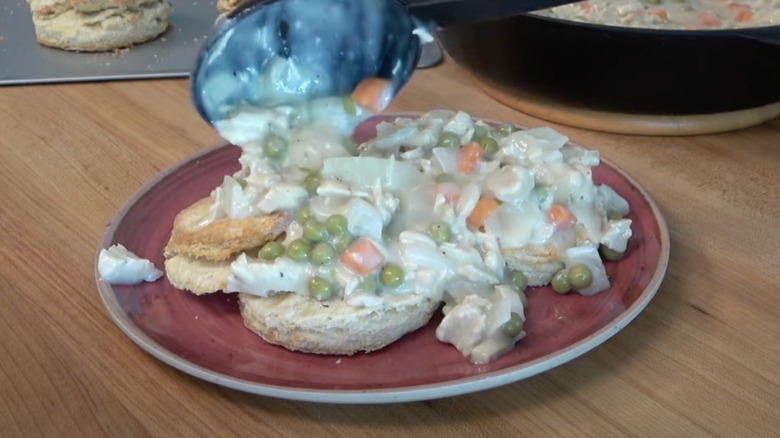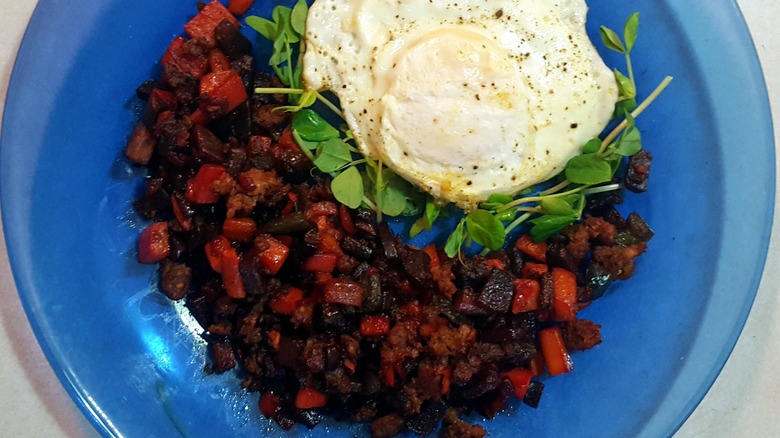10 Working Families' Dinners That Faded Away
The history of American food is dynamic, rich, and full of story. Nowadays, American cuisine is hugely diverse and defined by countless international influences, driven both by food trends and migration to the United States from various countries. Dive further back, though, and it tells a tale of the country's economy and needs of the people. For much of the 19th and 20th centuries, food was seen as something that provided energy and satisfaction to working folks who needed to stock up after a long day. There was a big emphasis on keeping things affordable and repurposing ingredients to avoid food waste, and less of a premium on vitamins, minerals, and nutrition.
All of these traits can be seen in many classic working family dinners that have since fallen out of fashion. Former favorites like creamed chipped beef, liver and onions, and Hoover stew were designed and eaten for their thriftiness — and in doing so, they became comforting favorites that some folks still remember today. Other dishes, like shipwreck casserole and red flannel hash, were created partly to employ disparate ingredients in one tasty dish in a way that'd keep people full. Let's take a look at the dinners that kept working families going back in the day.
Creamed chipped beef
Before creamed chipped beef was on dinner tables around the country, it was a dish served to hungry (and often disgruntled) soldiers. The meal was commonly served on toast to soldiers during World War I, who frequently detested its gloopy, stodgy nature. Creamed chipped beef was frequently referred to as "SOS," which stood for "Same Old Slop" — although there's an R-rated version of the acronym which we'll leave readers to search for themselves. In short, it wasn't popular.
However, over time the popularity of creamed chipped beef grew, and once it left the confines of the army it landed in people's homes, specifically during the Great Depression. Creamed chipped beef was valued for its thriftiness and ability to provide a combination of protein, fat, and carbohydrates in one go, without breaking the bank. It was also attractive due to the fact that you could make chipped beef without having to use fresh meat: The dish is created by using dried pieces of beef similar to jerky, which can keep in the refrigerator or pantry for a good while. Naturally, though, the combo of dried meat, thick white gravy, and bread isn't the most nutritious thing in the world, and over time it faded from view as families pursued slightly healthier options for their dinner.
Porcupine meatballs
We've got a lot of love for porcupine meatballs. Sure, they may be slightly strange to look at (rest assured, they're not made with actual porcupine), but they have a one-pot nature that really appeals to time-strapped folks around the country, and they combine their ingredients in a smart, cost-effective way. It was these qualities that appealed to folks in the Great Depression, the time when porcupine meatballs took off as a dinner staple, although they may well have been invented before then. All people had to do was combine ground beef, rice, onions, and tomato soup and simmer them together, and they had a hearty meal on the table in no time.
Porcupine meatballs' name comes from their appearance: When they're cooked, the rice sticks out of each ball in little spikes, giving them the appearance of the famous rodent. Although this does give them a visual flair, over time it came to be seen as a little retro and unrefined. The consequence of this was that porcupine meatballs eventually became kind of uncool to make, and they dropped off the radar. We think it's high time they came back, though.
Macaroni and tomatoes
Like many of the best comfort foods, macaroni and tomatoes came out of challenging economic circumstances. This dish was born during the Great Depression, a time when people relied heavily on cost-effective foods that provided sustenance on a budget. Canned foods like tomatoes and dried ones like pasta were high on people's shopping lists. There are plenty of ways to combine tomatoes and noodles, of course — doing so is one of the cornerstones of Italian cuisine — but macaroni and tomatoes is an American spin, and was especially popular in the South and in Appalachia.
At its core, macaroni and tomatoes is exactly what it sounds like: You cook the noodles in the tomatoes until they're soft, and you're done. However, in practice, that combo served as a base for various other ingredients which served to amp it up. Butter was a staple in the dish, and sugar, salt, and pepper were added for flavor. More sophisticated recipes might call for garlic, dried herbs, or meat to give it extra bulk. You could probably use other pastas, too, but we think sticking to macaroni is the traditional way.
Liver and onions
As old-school working families' dinners go, liver and onions is one that has held on the longest. In more traditional restaurants in the South, you may well find plates of this being served today, which is a testament to its staying power and the nostalgia it evokes. Liver and onions isn't just an American dish, either: It can be found in various forms around the world, particularly in European and South American food cultures. In the United States, though, it quickly gained popularity in the Great Depression and remained so during World War II as a dish that could deliver affordable animal proteins to families during times of rationing and scarcity.
Although eating liver on its own can be a tricky task due to its strong, almost metallic taste, the onions in the dish help to make them way more palatable. As a root vegetable, onions were (and are) also very cheap, which helped to keep this dish thrifty. Liver with bacon and onions was a variation that is still popular today among some folks, thanks to the bacon's umami flavor lifting both the liver and the onions to new heights. Liver and onions started to lose their foothold after World War II, as new food trends swept in and meat became more readily available. For many, though, it still acts as a doorway to days gone by.
Salisbury steak
Salisbury steak is one of those working dinners that we think is on the cusp of a comeback. This dish first started taking off during the Civil War, and was the brainchild of James Henry Salisbury, a physician who believed that protein consumption was the key to stopping gastrointestinal issues — and who also held the view that chopped beef would be easier to digest. His namesake, Salisbury steak, was a close relation to the hamburger (then known as the Hamburg steak) which became popular toward the end of the 18th century. Chopped beef was here to stay, folks.
Salisbury steak recipes can be found in Navy cookbooks dating back to the early 20th century, and they were reprinted for decades. Soon enough, these steaks left the confines of the Army and started being made in homes around the country. It was also a staple of TV dinners, which offered working families a hearty meal without any prep or cleanup. By the end of the 20th century, however, Salisbury steak had started to take on a bit of a vintage feel. You can still find it in more old-school diners and cafeterias, but it's lost its spark — although we think that people are due to fall in love with its cost-effective nature once more.
Hoover stew
We just love it when a meal takes on a political edge. If you want an example of that happening in working dinner form, look no further than Hoover stew. This dish, like so many classic working family dinners, was born during the Great Depression. During this time people were forced to look for ways to feed their families for less, and they resented the people at the top. This included Herbert Hoover, the president of the United States from 1929 to 1933 who was seen to have delivered an inadequate response to the Great Depression. People were angry at having to scrimp, and Hoover stew was named after the person who made them do it.
There were two things about Hoover stew that came above all else: It needed to be substantial, and it needed to be cheap. As a result, the dish came to be based around dried macaroni, with other canned or preserved ingredients like hot dogs, beans, and tomatoes also being thrown into the pot. Canned vegetables could be a feature, and offered a little bit of nutrition. The dish was commonly cooked and served in Hoovervilles, shantytowns which were once again named after the unpopular president. Although Hoover stew is rarely seen nowadays, it's lost none of its potency.
Creamed chicken over biscuits
We've all heard of biscuits and gravy, but creamed chicken over biscuits is one for those folks who like something just a touch lighter. While the invention of creamed chicken over biscuits remains unclear, it's likely that it stemmed from biscuits and gravy, which allegedly first became popular in Southern Appalachia in the 1800s. Throughout the 20th century it became one of those dishes that countless moms and grandmas had a recipe for to feed their families, and it may have also been a go-to dish in Amish communities.
The great thing about creamed chicken over biscuits was that it used up leftovers super easily. If you had any shredded chicken lying around, or a couple carrots and a handful of peas that needed using, you could whip it up in no time. The invention of the biscuit tube, and the subsequent ability it gave Americans to make baked biscuits at home without having to work from scratch, no doubt made this dish more popular. Nowadays, creamed chicken over biscuits has been forgotten about in favor of its more well-known sibling — but it's still worth a try.
Cube steak
For a long time, cube steak was the go-to beef product for folks who needed protein fast and cheap. Cube steak was first pioneered in the 19th century, and was invented when ranch workers were looking to find a way to make beef cuts from older cattle more tender and palatable. A meat tenderizer which punctured the meat was created, and it allowed these ranchers to stop throwing this beef away — and to sell it at a cheaper price.
It took a while for cube steak to take off. However, in the 1900s it became an attractive choice due to its affordability and use in dishes like chicken-fried steak and braised cube steak. Families could get their quota of beef for a reasonable cost, and the ranch hands were shifting old stock; everyone was happy. The steak never totally disappeared, but as the century rolled on it definitely began to be seen as something people bought when they were scrimping on better options. Plus, as beef production started to ramp up, folks could suddenly afford something a little better. Cube steak became a choice that you'd only reach for if you were feeling nostalgic, and today it's most people's last choice.
Shipwreck casserole
Few dishes have as good a name as shipwreck casserole. This meal is a classic example of what happens when people get resourceful in the kitchen, with the primary intention of creating something filling out of essentially whatever's lying around. Shipwreck casserole apparently began appearing in the 1940s (although some people claim that it was actually a Depression-era dish) and was a feature of cookbooks for a good couple of decades. Over time, though, it largely got forgotten about, and today it's rare for people to make it.
Maybe that's because no-one could ever really agree what shipwreck casserole actually was. The common threads throughout recipes for it were ground beef and canned tomatoes, but beyond that it seems like what went into it was up to the cook. Some people used rice, some used potatoes, others opted for hash browns and still others used beans. Chopped or canned vegetables generally featured, but that wasn't a given. While some folks liked to top their casseroles with cornflakes, others popped cheese on top or just left the interior exposed to the heat of the oven. Perhaps that's how the casserole got its name: This was a jumbled-up, messy-looking dish containing whatever washed up on the shores of your kitchen pantry.
Red flannel hash
Red flannel hash is a meal that can be tied pretty strongly to innovations in food technology. This dish first became popular in the 1910s, at a time when food canning was becoming increasingly sophisticated and widespread. Corned beef and canned beets became everyday staples that people used to cook with, and the appeal of canned food was made even stronger by World War I, which ushered in a new era of rationing and saving.
Out of this context came red flannel hash, a meal highly popular in New England among Irish-American communities. Corned beef and beets are combined with boiled potatoes and onions, and then everything's fried up in a cast iron skillet. The dish was particularly prized for its heartiness and while it was a dinner staple and a potluck favorite, it could also be enjoyed for breakfast. Its name came from the color that the beets gave the hash, which dyed the whole thing a glorious deep red. These days red flannel hash is seen as a slightly bygone dish, but if you're ever in New England you might be lucky enough to come across it.
